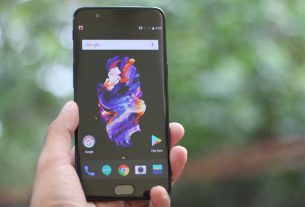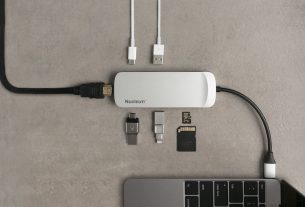Garmin has always been known as a sports and performance powerhouse, which is why it may seem like you have a mild case of déjà vu every time the brand launches yet another new wearable device. The Garmin Vivosmart HR+ is no exception, as it’s an updated version of the slightly dumbed-down Vivosmart HR, which launched in late 2015. The HR+ has had a small yet substantial upgrade on the original, because not only is it packing a heart rate sensor, but it’s GPS-enabled too, which means it really is a runner’s best friend.
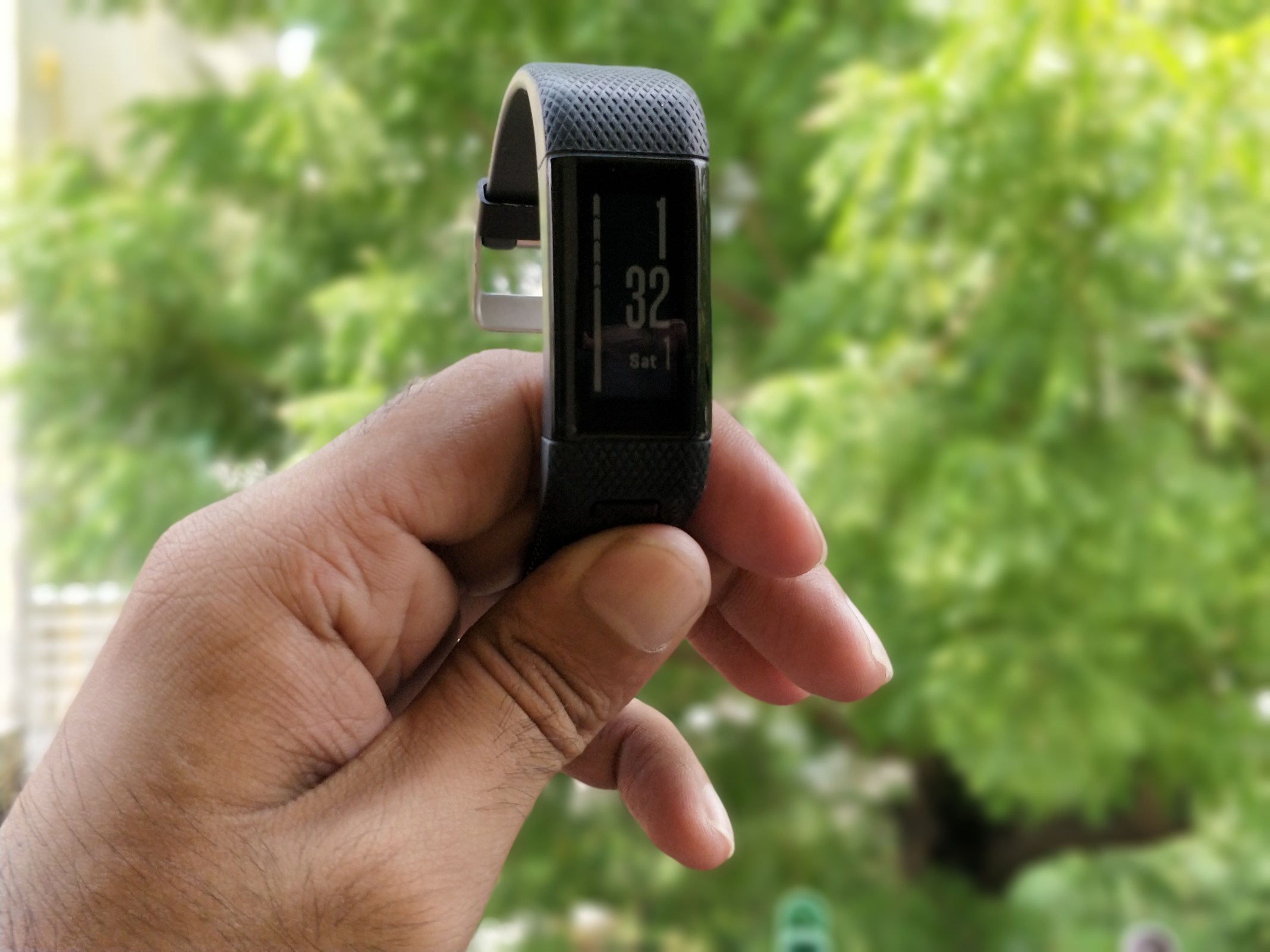
These are two huge pulls for those who are currently using a simple wearable like the Fitbit Alta or Misfit Shine, but feel like they need to take a step up to a device that’s much smarter and built for fitness rather than activity tracking.
But in many ways it’s not a device solely built for fitness (even though we think runners will get the most out of it). With the Vivosmart HR+, Garmin is definitely making a play to compete with all-singing and all-dancing devices like the Apple Watch and Fitbit Blaze, which can handle activity tracking, sleep and fitness, as well as notifications to boot.
Read on to find out whether we think the Garmin Vivosmart HR+ is a souped-up activity tracker or can compete with the smartwatch elite.
Design
- Durable plastic and rubber body
- Not the most attractive device
GARMIN VIVOSMART HR+ SPECS
Compatibility: Android and iOS
Display size: 2.5 x 1.1cm
Display resolution: 160 x 68
Battery: up to 5 days
Charging method: USB via cradle
Water resistant: up to 5ATM
Connectivity: Bluetooth, GPS
Like most of Garmin’s other products, the Vivosmart HR+ isn’t pretending to be a modern take on the classic watch – a style we’ve seen touted by a number of similar brands. Instead, it’s a device built for fitness through and through.
Made from plastic encased in a rubber strap and body, the durable design ensures the HR+ withstands knocks and drops to the floor (yes, we accidentally dropped it more than once and can safely say it survived intact).
Its traditional buckle-style strap means it stays super secure, even running on the roughest terrain.
At first this feels a little heavy duty in comparison to other wearables, but the fact it barely moves is a huge advantage over the style adopted by the likes of the Jawbone UP3, which is prone to sliding around during particularly grueling workouts.
Sure this sensible, durable and unashamedly fitness-driven style will be a huge turn-off for some. But a device that’s built to get the job done and values a simple, tried-and-tested aesthetic over an achingly stylish one actually feels refreshing, (although that’s maybe a sign we’re getting older and more boring.)
But once you delve deeper, you find that the HR+ really does favor substance over style. For example, the rubber exterior and sunken home button mean the device has a decent amount of waterproofing.
Just like Garmin’s other wearables, the Vivosmart HR+ is water resistant to 5ATM, which is around 50 meters. This means you don’t have to worry about it in the bath or the shower and can even take it swimming – even though there’s no dedicated swimming mode. Sad face.
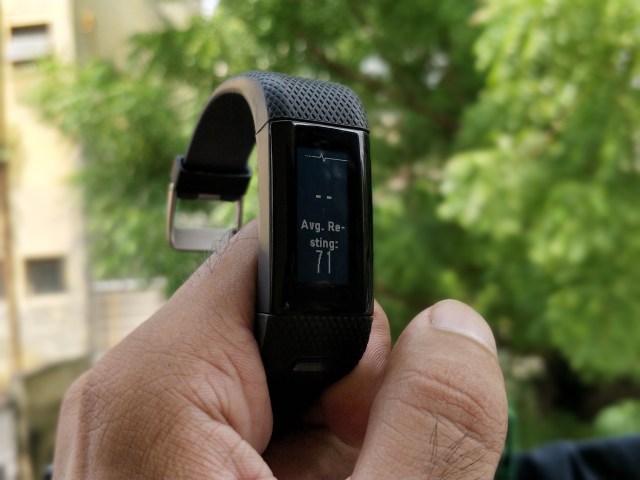
We were sent the HR+ in black, but it comes in a few different shades, like purple and blue. The wearable appears slim, but it’s very chunky depth-wise. Its subtle style means it works well at work, home and in the gym, but those with smaller wrists be warned: it doesn’t always play nice with sleeves.
At 160 x 68 pixels the screen is fairly small with a low resolution. This means it doesn’t feel particularly sharp and it doesn’t have a backlight either. But funnily enough this doesn’t affect the user experience at all (more on this later).
The main button under the screen, which you use to bring up the main menu, is slightly indented. This makes it easy to press, but on the flip side, I never accidentally pressed it either. On the underside of the device you’ll find the heart rate sensor, as well as a charging dock.
Under the hood, the Vivosmart HR+ has everything you’d expect from a high-end tracker, including a built-in heart rate monitor, GPS, accelerometer and barometric altimeter. This means it sits nicely between activity tracking devices and those designed solely with fitness in mind.
When it comes to activity tracking, your steps clock up throughout the day to work towards a goal that Garmin has set for you – although you can change it from within the app. Once you hit that goal cue little vibrations and alerts that tell you you’re doing well.
Generally, Garmin’s step counter seemed accurate and was within a few hundred steps of a few other devices we tested it against, like the Misfit Ray and Jawbone UP3.
A nice addition here is the move bar, which basically tells you when you need to move. It builds up over an hour or so and then you can walk it off. Other devices from Fitbit and Jawbone have a similar feature, but Garmin does it well because you can watch it slowly build up and it simply prompts you to move – rather than just annoying you.
Although the HR+ can be used solely as an activity (and sleep) tracker, it really excels when it comes to fitness – especially running.
Press the home button and you’ll be greeted with a bunch of options. The first one is a little stick dude. Click him and you can choose from Running, Cardio or Other.
Once within the Running option, you can specify whether you’ll be indoors or outdoors – if you select outdoors, the HR+ will put the GPS to good use, as well as tracking your pace, distance, calories and time. It displays one thing at a time once you’ve completed your run, which you can then swipe through.
There are no dedicated modes for full GPS-tracking of other activities, which is a shame. Although, selecting Other will present you with distance, time, BPM and calories burned. The results here are decent, but nowhere near as detailed as they could be – especially if you’re really into cycling and swimming.
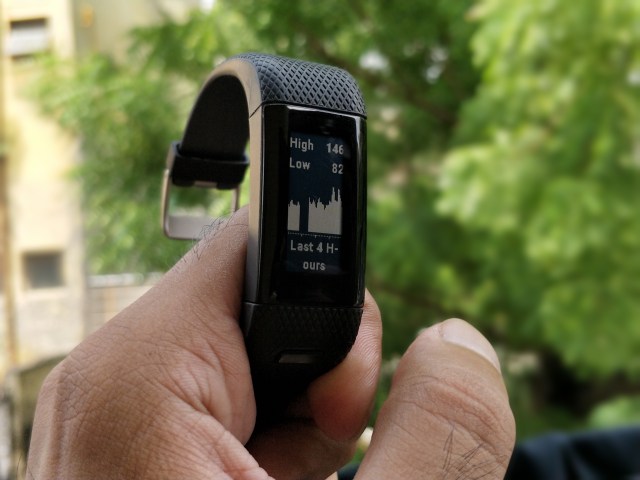
The device has one button on the front and a touchscreen. You only really have two sets of controls. You can press the button to see the main menu, or swipe up. This keeps the functionality really simple and, after just an afternoon’s wear, quickly became really intuitive and easy-to-use.
We think this is vital for a wearable created to be used for running and high intensity activities – no one has the bandwidth to perform well and fiddle around with confusing menus.
Although there’s nothing particularly exciting about the touchscreen it allows you to quickly swipe through all kinds of data. This includes the time, which is always displayed, your daily steps, stairs climbed, active minutes, calories burned, distance travelled, music controls, weather, your notifications and then heart rate.
Wow, that’s a lot, right? And the fact that swiping through it feels simple and intuitive is a real testament to Garmin’s consideration of the user journey here.
The device’s 24/7 heart rate tracking performs well. It collects your resting heart rate throughout the day, which you can see within the accompanying Garmin Connect app or live on your wrist by finding the right screen as you swipe.
When you’re working out the heart rate works fairly seamlessly, providing a slightly delayed experience when we upped the intensity of our workouts – but it caught up eventually.
The Garmin Vivosmart HR+ tracks your sleep automatically and sends the data through to the app for closer inspection. On testing it, we found it tracks sleep accurately enough, but it doesn’t present data as in-depth as some other apps, like Jawbone. This is fine if you’re only mildly interested in sleep tracking, but it might be worth looking at other options if it’s your number one priority.
The one thing that sets the Garmin Vivosmart HR+ apart from simpler trackers, is it’ll ping notifications from your phone over to your wrist. There’s not much to say about this feature, other than it works instantly and everything gets sent there.
It’s always reliable (if a bit relentless), sending calls, messages, Facebook messages and anything else right to your fingertips and you can tap into certain messages to read a bit more. You won’t be able to read everything, but you’ll get the gist.
Like other Garmin devices, the Vivosmart HR+ syncs up with the Garmin Connect app. We’re torn with the Garmin Connect app, because on the one hand the depth and richness of data on display is really extensive, allowing you to dig deeper into all kinds of stats.
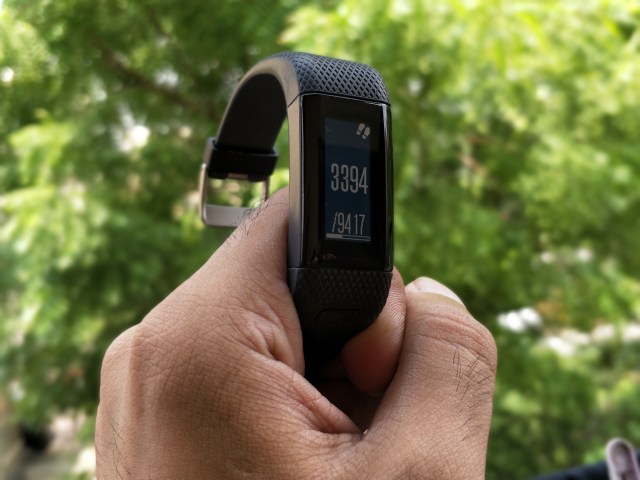
But it’s also a bit confusing and can take a while to figure out where everything lives, even after a few days of use, which feels like a letdown when the wearable itself is just so simple, but maybe that’s the whole point. Your wrist is for simplicity; your app is for everything else.
The app displays snapshots of your data, like daily stats, steps and a workout leaderboard, as well as a calendar of all your past workouts, on the home page. But you can customize that and move whatever you like to the front page. So there are plenty of options to simplify and streamline your experience.
The Vivosmart HR+ doesn’t support any external HR chest straps, which is surprising because many other Garmin products do. The thinking here is likely that the wrist-based sensor is enough, which goes to show this is definitely a high-end tracker – and ideal for fitness – but those with serious training in mind might need something smart, like one of the brand’s Forerunner range.
One thing the Vivosmart does do well is send your heart rate to other devices in the Garmin ecosystem, like the VIRB cameras. Although we’re not sure how many diehard Garmin fans are out there with that many products from the brand.
The Garmin app works with both iOS and Android devices, although there’s also a web portal. This works with devices connected to a PC or Mac, so pretty much anyone can use it.
Battery life
- 5 to 6 days on a single charge
- Charging cradle can be fiddly
The battery on the Vivosmart HR+ tends to last between five and six days. That’s using all of the features, getting far too many notifications and taking it out for a handful of indoor runs as well as a few outdoor runs using GPS.
In comparison to some of the more basic trackers on the market this seems short, but taking into account just how many sensors are doing their thing at once, it’s actually pretty impressive.
According to Garmin, the device would only last about 8 hours if you were to have the GPS on constantly, although we didn’t have time to go on an 8 hour+ run or hike to put that to the test.
To charge up the Vivosmart HR+ you connect it to a cradle that plugs into your computer via USB. It kind of ‘clicks’ into place and felt a bit fiddly at first.
A few weeks on, it doesn’t bother us too much, but it does mean there’s an extra thing to pack if you’re travelling. Hardly a deal-breaker, but just a bit annoying.
Verdict
The Garmin Vivosmart HR+ is one of our favorite wearable devices for fitness because it serves up all of the data you need and it does it in a way that feels intuitive and, refreshingly, easy.
Who’s this for?
The HR+ is not likely to pique the interest of those after a super stylish device, or one that looks like a traditional timepiece. But having said that, it’s not as if it looks particularly bad. It’s for those who value substance, good data and a subtle device over aesthetics.
It’s ideal for those who need something more than a Misfit Shine or Fitbit Flex, but don’t workout enough to justify a heavy duty running device that looks like a computer strapped to their wrist – not to mention the price tag to match, like Garmin’s much more serious Forerunner range.
On the other hand, you don’t have to be smashing out the 5km runs to appreciate it. If you just need an activity tracker for now, but know you want to take fitness a little more seriously, investing in this device would give you a great excuse, and means you won’t be clamoring for more functionality and better sensors a few months in when hitting 10,000 steps just doesn’t do it for you anymore.
Should you buy it?
The Vivosmart HR+ falls short for specific tracking of some activities – notably swimming and cycling – which is disappointing. But if you’re that into swimming there are plenty of other devices at your disposal, like Misfit’s Speedo Shine.
For runners though, particularly those who value substance over style, the Garmin Vivosmart HR+ could be the wearable your wrist has been missing.

